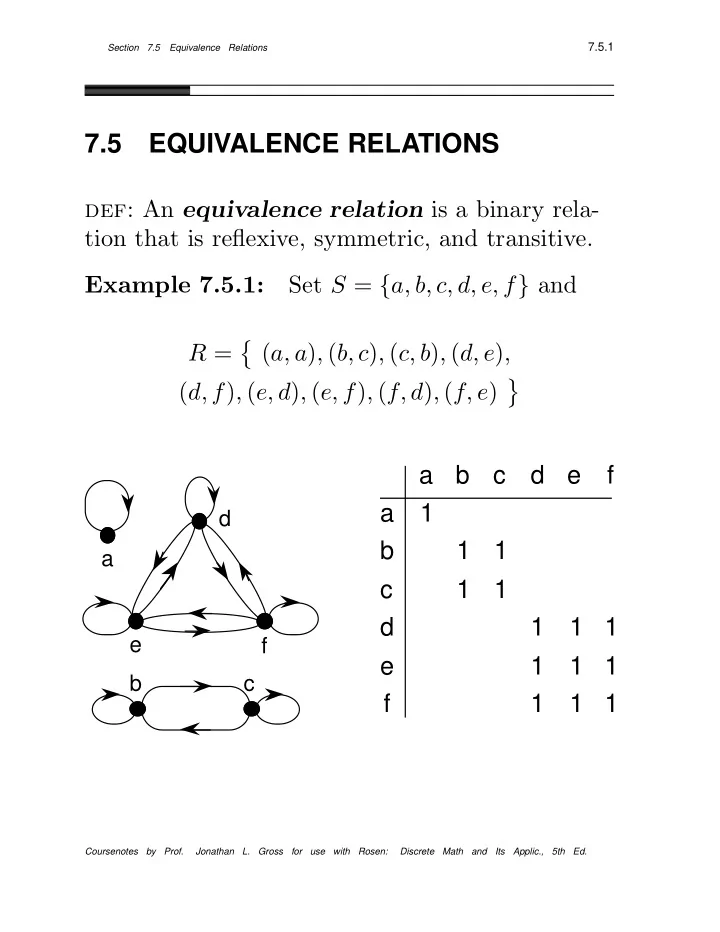

7.5.1 Section 7.5 Equivalence Relations 7.5 EQUIVALENCE RELATIONS def: An equivalence relation is a binary rela- tion that is reflexive, symmetric, and transitive. Set S = { a, b, c, d, e, f } and Example 7.5.1: � R = ( a, a ) , ( b, c ) , ( c, b ) , ( d, e ) , � ( d, f ) , ( e, d ) , ( e, f ) , ( f, d ) , ( f, e ) a b c d e f a 1 d b 1 1 a c 1 1 d 1 1 1 e f e 1 1 1 b c f 1 1 1 Coursenotes by Prof. Jonathan L. Gross for use with Rosen: Discrete Math and Its Applic., 5th Ed.
7.5.2 Chapter 7 RELATIONS Prop 7.5.1. Let R be an equivalence relation. Then every component of the digraph of R is a ♦ complete digraph. Cor 7.5.2. An equivalence relation induces a partition on its domain. The vertex set of each component of Proof: the digraph is a cell of the partition. ♦ Prop 7.5.3. Let R be an equivalence relation. Order its domain so that the elements of each cell of the induced partition occur contiguously. The resulting matrix represention has blocks of square matrices of all 1’s down its main diagonal and has all zeroes for its other entries. ♦ Coursenotes by Prof. Jonathan L. Gross for use with Rosen: Discrete Math and Its Applic., 5th Ed.
7.5.3 Section 7.5 Equivalence Relations FINITE EQUIVALENCE RELATIONS 2 × 2 checkerboards Example 7.5.2: There are 16 checkerboards. Checkerboard x is related to checkerboard y if it can be trans- formed into y by a rotation or by a reflection. relation R = sibling of Example 7.5.3: domain = all persons The reflexive, trans. closure of R is an eq rel. It partitions all of humanity into equivalence classes of (full) siblings. Coursenotes by Prof. Jonathan L. Gross for use with Rosen: Discrete Math and Its Applic., 5th Ed.
7.5.4 Chapter 7 RELATIONS INFINITE EQUIVALENCE RELATIONS domain = rational fractions Example 7.5.4: � p � � � p, q ∈ Z , q � = 0 � q a b and c Then are related if ad = bc d The partition cells are rational fractions of equal value. COUNTING PROBLEM (solved in w4205): How many cells are there if p, q ∈ { 1 , . . . , 10 } ? domain Z Example 7.5.5: eq. rel. = congruence mod 3 Equivalence Classes: [0] 3 = { . . . , − 6 , − 3 , 0 , 3 , 6 , 9 , . . . } [1] 3 = { . . . , − 5 , − 2 , 1 , 4 , 7 , 10 , . . . } [2] 3 = { . . . , − 4 , − 1 , 2 , 5 , 8 , 11 , . . . } domain = propositions on Example 7.5.6: p, q (infinite domain – arbitrarily long strings) eq. rel. = logical equivalence N.B. there are 2 4 cells to this partition Coursenotes by Prof. Jonathan L. Gross for use with Rosen: Discrete Math and Its Applic., 5th Ed.
Recommend
More recommend